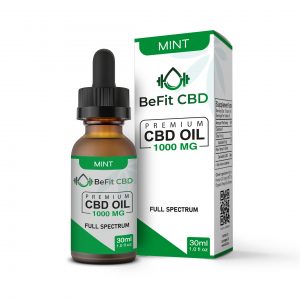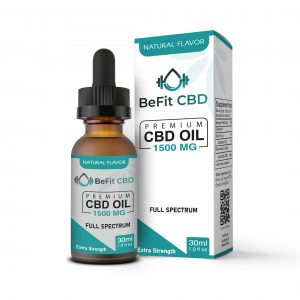BeFit CBD offers a new line of products that combine advanced science with the finest organic and natural ingredients, engineered to deliver powerful relief and relaxation.
What Is Full Spectrum CBD Oil?
Full Spectrum CBD Oil is the oil derived from industrial hemp plants. It is made from the entire hemp plant, thus the term “full-spectrum hemp oil.”
CBD is one of many cannabinoids found in the hemp plant. Most products on the market are actually hemp extracts with a broad spectrum of ingredients, such as vitamin E, coconut oil, chlorophyll, terpenes, and somewhere from 50 to over 100 cannabinoids, including CBD.
CBD is short for cannabidiol, a compound extracted from the hemp plant.
By definition, CBD is short for cannabidiol, a compound that is extracted from the hemp plant.
Note: Some CBD oil products may contain very low levels of THC, the compound in cannabis that produces a “high,” but having it doesn’t mean you’ll get high.
There are all sorts of claims about its benefits for health and wellness , but in this article, we will cover general areas with medical research that back these claims up. You’ll find links to many studies at the end of the article.
There is a male and a female cannabis plant. The female plant is also called by the slang marijuana, but its correct name is cannabis. Hemp, the male plant, is the one we will discuss.
Put another way, this one plant (cannabis) has two species. Hemp (does not get you high) and marijuana (gets you high).
| CBD/Hemp | Marijuana |
| Full-spectrum CBD oil from true industrial hemp will not get you “high”. | Associated with the feeling of being high. |
| Hemp can contain no more than 0.3% THC. | Marijuana can contain up to 30% THC. |
| Federally legal with the passing of the 2018 Farm Bill Act. | Illegal in most states without a Medical Marijuana Card. |
| Primarily used for it’s many potential health benefits. | Mostly used for recreational purposes. |
Today, most people seem to be seeking alternatives to addictive pharmaceutical opioids, which have harsh side effects. They want medicine that is more in tune with their body’s natural cycle. By tapping into our biological functions on a molecular level, CBD can provide relief from most pain and inflammation.
A Word About Full-Spectrum CBD Oil vs. CBD Isolate
Some manufacturer labels will state whether their CBD is full-spectrum or not.
Full-spectrum CBD oil, or oil from the whole plant, means that the product contains other cannabinoids. This also means that that product may contain trace amounts (0.3% or less) of THC, along with cannabinol (CBN) and tetrahydrocannabivarin (THCV).
Other cannabinoids could include CBL and CBCVA, and some manufacturers may add scented cannabis terpenes, such as pinene, terpinolene, ocimene, or limonene.
See the terpenes list below. Some clinical researchers have found that full-spectrum CBD may be more potent due to synergistic reactions with terpenes and minor cannabinoids present. Also, keep in mind that trace amounts of THC in full-spectrum CBD oil could potentially compromise a drug test.
If the label states that it is only CBD, you know what you’re getting – nothing but CBD. You must read the labels and understand what is in the product you want to use.
Full-spectrum CBD oil refers to an oil or product containing all the cannabinoids found in the cannabis plant. Full-spectrum CBD oils are associated with the “entourage effect” – this refers to the high level of effectiveness of these products resulting from different cannabinoids working synergistically.
Full-spectrum CBD oil tends to be more potent than other CBD oils. Products derived from CBD usually contain only the isolated CBD molecule.
| Cannabinoid | ID | Weight %/g |
| Delta-9 Tetrahydrocannabinol | Δ9-THC | 0.17% |
| Tetrahydrocannabivarin | THCV | ND |
| Cannabidiol | CBD | 4.83% |
| Cannabidivarin | CBDV | 0.08% |
| Cannabigerol | CBG | 0.06% |
| Cannabichromene | CBC | 0.14% |
| Cannabinol | CBN | 0.02% |
| Tetrahydrocannabinolic Acid | THCa | ND |
| Cannabidiolic Acid | CBDa | ND |
| Cannabigerolic Acid | CBGa | ND |
| ND = None Detected |
Full-spectrum CBD oil offers more than 100 different cannabinoids found in the hemp plant. CBD and THC are found in high proportions in the cannabis plant, but other less popular cannabinoids can influence the effectiveness of CBD.
These phytocannabinoids are present in both industrial hemp plants and medical marijuana plants. This is because they come from the cannabis plant known as Cannabis sativa. However, there are different kinds of hemp products that can all be advertised as “hemp oil,” and it can be hard to keep them all straight. Luckily, we’ve got you covered.
Quick Overview Of The Endocannabinoid System
CBD, CBN, and THC fit like keys into the lock of existing receptors that humans have.
These receptors are part of the endocannabinoid system, which impacts physiological processes affecting pain modulation, memory, and appetite, as well as anti-inflammatory effects and other immune system responses.
The endocannabinoid system is comprised of two types of receptors, CB1 and CB2, which play different roles in human health and well-being.
- CBI receptors are primarily found in the brain and central nervous system, as well as in other tissues to a lesser extent.
- CBD does not directly “fit” CB1 or CB2 receptors, but it has powerful indirect effects that are still being studied.
- CB2 receptors are mostly in peripheral organs, especially cells associated with the immune system.
This illustration shows what we’ve learned over the last 30 years in discovering the ECS. This is the best explanation I’ve found in 40 years of using the entire cannabis plant to treat my own issues.
Hemp cannabinoid extract affects the endocannabinoid system by activating the CB1 and CB2 receptors located throughout the body.
The endocannabinoid system (ECS) regulates the proper functioning of a wide range of the body’s processes.
The main mechanisms of the endocannabinoid system govern pleasure, energy, and well-being, and they help support the body in returning to health when injured or fighting off disease.
Where Endocannabinoid System Receptors Are Found in the Body
- nervous system
- immune system
- digestive system
- endocrine glands
- brain
- heart
- lungs
- kidneys
- liver spleen
- bones
- muscles
- blood vessels
- lymph cells and fat cells
Think of the endocannabinoid system as a car. A car is made up of various systems.
Such as:
- the cooling system
- the ignition system
- the sound system
- the braking system, etc.
- the heating, and air system
For the last thirty years, cars have come off the line with a computer system. That computer system is attached to sensors located throughout the vehicle.
You find them in the engine, the gas tank, the wheels, the exhaust, the brakes, and elsewhere. Sensors alert you when there is a possible problem.
There is one thing that ties everything together; it’s called the wiring harness. The wiring harness connects the ignition switch to the battery, to the computer, to its sensors, to run the engine. You drive until your tire sensors tell you, you have low air pressure or when it’s time for an oil change. Each system has a purpose and a function; this way, each part of the car operates without failure.
The endocannabinoid system is like that wiring harness. It connects your brain (the computer) to your heart (the battery). It then connects to the rest of your body, the limbs, the internal organs, the body’s largest organ, the epidermis, and its sensors, cannabinoid (CB1 & CB2) receptors. It ties everything together and reports back to the brain just as the sensors do on your car. Then the brain releases its own chemicals as the body needs.

 FREE SHIPPING ON ALL PRODUCTS
FREE SHIPPING ON ALL PRODUCTS


